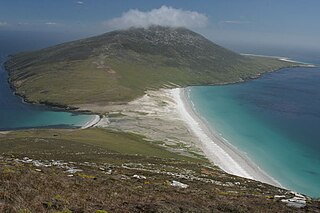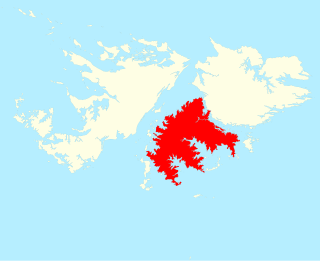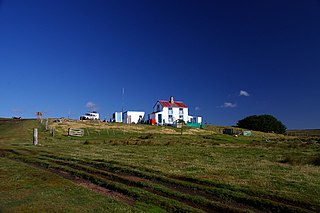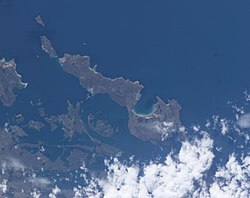
The Falkland Islands are located in the South Atlantic Ocean between 51°S and 53°S on a projection of the Patagonian Shelf, part of the South American continental shelf. In ancient geological time this shelf was part of Gondwana, and around 400 million years ago split from what is now Africa and drifted westwards from it. Today the islands are subjected to the Roaring Forties, winds that shape both their geography and climate.

HMS Coventry was a Type 42 (Sheffield-class) destroyer of the Royal Navy. Laid down by Cammell Laird and Company, Limited, at Birkenhead on 29 January 1973, she was launched on 21 June 1974 and accepted into service on 20 October 1978 at a cost of £37,900,000.

Lively Island is the largest of the Lively Island Group of the Falkland Islands, The island group lies east of East Falkland. Lively Island is the largest rat-free island in the Falklands, hence its importance to birdlife. The island also has a sheep farm.

Speedwell Island is one of the Falkland Islands, lying in the Falkland Sound, southwest of Lafonia, East Falkland.

Bleaker Island is one of the Falkland Islands, lying off south east Lafonia. The name is a corruption of "Breaker Island" due to the waves that break on it. It was also known as "Long Island" at one point.

Carcass Island is the largest of the West Point Island Group of the Falkland Islands.

Saunders Island is the fourth largest of the Falkland Islands, lying north west of West Falkland. The island is run as a sheep farm.
Keppel Island is one of the Falkland Islands, lying between Saunders and Pebble islands, and near Golding Island to the north of West Falkland on Keppel Sound. It has an area of 3,626 hectares and its highest point, Mt. Keppel, is 341 metres (1,119 ft) high. There is a wide, flat valley in the centre of the island with several freshwater lakes. The central valley rises steeply to the south-west, west and north. The north-east is low-lying, with a deeply indented coastline.

Sea Lion Island is the largest of the Sea Lion Island Group of the Falkland Islands. It is 9 km2 (3 sq mi) in area. and lies 14 km (9 mi) southeast of Lafonia. It was designated a Ramsar site on 24 September 2001, and as an Important Bird Area. In 2017 the island was designated as a National Nature Reserve.

West Point Island is one of the Falkland Islands, lying in the north-west corner of the archipelago. It has an area of 1,469 hectares (5.67 sq mi) and boasts some of the most spectacular coastal scenery in the Falklands. The island is owned by Roddy & Lily Napier and run as a sheep farm and tourist attraction.

Lafonia is a peninsula forming the southern part of East Falkland, the largest of the Falkland Islands.

Goose Green is a settlement in Lafonia on East Falkland in the Falkland Islands. It lies on Choiseul Sound, on the east side of the island's central isthmus, 2 miles (3.2 km) south-southwest of Darwin. With a population of about 40, it is the third-largest settlement of the Falkland Islands, after Stanley and Mount Pleasant.

The Camp is the term used in the Falkland Islands to refer to any part of the islands outside the islands' only significant town, Stanley, and often the large RAF base at Mount Pleasant. It is derived from the Spanish word campo, for "countryside".

The Falkland Islands Company Ltd is a diversified goods and services company owned by FIH Group. Known locally as FIC, it was founded in 1851 and was granted a royal charter to trade in 1852 by Queen Victoria. It was originally founded by Samuel Fisher Lafone to exploit wild cattle in East Falkland, but they gave way to sheep farming and then to a range of trading activities in the Falkland Islands ranging from retail shops and cafés to insurance and vehicle hire.

The Raid on Pebble Island was a raid by British Special Forces on Pebble Island's airfield during the Falklands War, and took place on the night of 14–15 May 1982. Pebble Island is one of the smaller Falkland Islands, lying north of West Falkland. The site was being used as a forward operating base for T-34 Mentor and Pucara aircraft by the Argentine Air Force; British Special Air Service (SAS) operatives were tasked with destroying the aircraft on the ground, in an operation that echoed back to some of the unit's first missions during the North African Campaign of World War II. SAS elements, then embarked on HMS Hermes, were tasked with eliminating the airfield, with naval support from the Type 22 frigate HMS Broadsword as Hermes defensive escort and the County-class destroyer HMS Glamorgan to provide naval gunfire support with its Mark 6 4.5 inch guns.

The Falkland Islands is an archipelago in the South Atlantic Ocean on the Patagonian Shelf. The principal islands are about 300 mi (480 km) east of South America's southern Patagonian coast and about 752 mi (1,210 km) from Cape Dubouzet at the northern tip of the Antarctic Peninsula, at a latitude of about 52°S. The archipelago, with an area of 4,700 sq mi (12,000 km2), comprises East Falkland, West Falkland, and 776 smaller islands. As a British overseas territory, the Falklands have internal self-governance, but the United Kingdom takes responsibility for their defence and foreign affairs. The capital and largest settlement is Stanley on East Falkland.
Port Stephens is a settlement and a harbour on West Falkland, in the Falkland Islands. It is on the far southwest of the island, near Calm Head and Cape Meredith and South Harbour is the nearest other settlement. Until recently, it was one of the Falkland Island Company's largest sheep stations. In 1989 the Company split the farm into five units which were all bought by former employees. Port Stephens is one of the five sections of the original Port Stephens farm and is owned by Peter and Ann Robertson. While the harbour itself is sheltered, the surrounding area is frequently battered by Antarctic storms. The location is highly rugged, and considered to be amongst the most scenic in the Falklands. There is a self-catering cottage at Port Stephens with access to penguin colonies.

Volunteer Point is a headland on the east coast of East Falkland, in the Falkland Islands, north-northeast of Stanley, and east of Johnson's Harbour and Berkeley Sound. It lies at the end of a narrow peninsula, which protects Volunteer Lagoon. It received its name in 1815, when the sealing ship Volunteer left a boat's crew there to collect seal skins while it went in search of opportunities elsewhere. Four years later, on 13 February 1820, the French research vessel L'Uranie struck a submerged rock just off the point but stayed afloat long enough to be beached in Berkeley Sound. All on board survived, including the Captain's wife, Rose de Freycinet, who recorded the incident in her diary.
Golding Island is one of the Falkland Islands, just to the north of West Falkland in Keppel Sound and near Keppel and Pebble Islands. It has a complex shape, with narrow headlands and bays, and a pond in the middle.
Hummock Island is the largest of a group of islands in King George Bay in the Falkland Islands. It has a land area of 3.03 square kilometres (1.17 sq mi) and is about 4.0 miles (6.4 km) long in a north-west to south-east direction. Hummock Island is off the western coast of West Falkland, in a bay that leads to the estuary of the Chartres River. The highest point on the island is in the north-east and is 190 metres (620 ft). There are cliffs which often reach over 60 metres (200 ft) high.

















